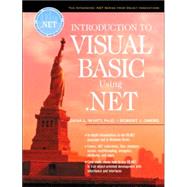
DANA L. WYATT, Ph. D. formed EMCA Consulting in 1993 to provide advanced object-oriented training, mentoring, and consulting services. She received a Ph.D. in Computer Science from Texas A&M University and taught computer science for 13 years at Texas A&M, TCU, and the University of North Texas, receiving a NASA-ASEE fellowship for research at NASA's Goddard Space Flight Center.
ROBERT J. OBERG is founder and President of Object Innovations, a leading developer of integrated courseware on fundamental software including Microsoft .NET, COM+, and Java. His books include Understanding and Programming COM+, Introduction to C# Using .NET and Application Development Using C# and .NET (Prentice Hall PTR). He is editor of The Integrated .NET Series. Oberg holds a Ph.D. from Harvard University.
I. INTRODUCTION TO .NET AND VB.NET.
1. .NET Framework.II. VB.NET AS A VISUAL BASIC LANGUAGE.
4. Fundamentals of VB.NET.III. OBJECT-ORIENTED PROGRAMMING IN VB.NET.
10. Object-Oriented Programming.IV. WINDOWS PROGRAMMING IN VB.NET.
15. Introduction to Windows Forms.V. VB.NET AND THE .NET FRAMEWORK.
18. Using the .NET Framework.The New copy of this book will include any supplemental materials advertised. Please check the title of the book to determine if it should include any access cards, study guides, lab manuals, CDs, etc.
The Used, Rental and eBook copies of this book are not guaranteed to include any supplemental materials. Typically, only the book itself is included. This is true even if the title states it includes any access cards, study guides, lab manuals, CDs, etc.